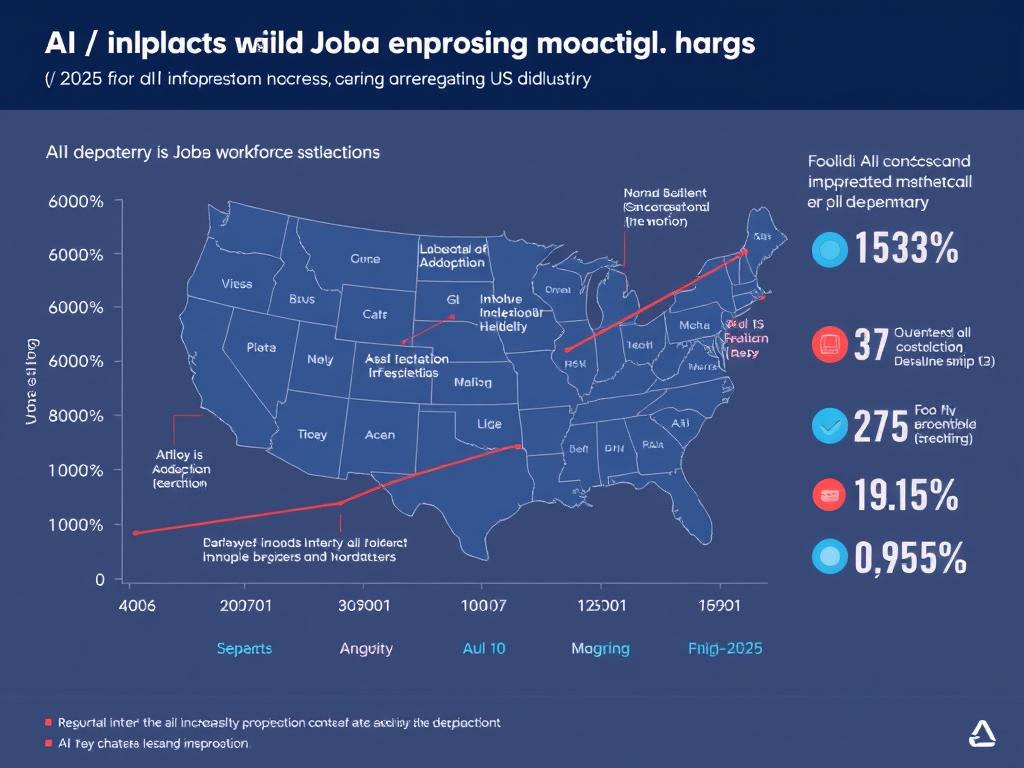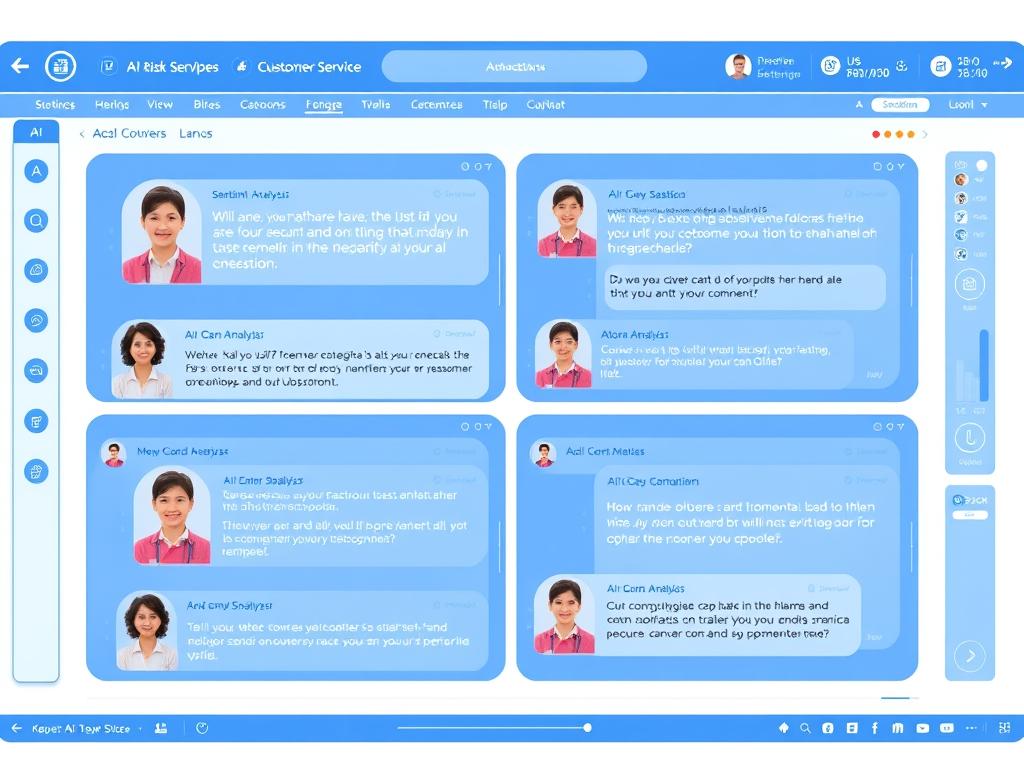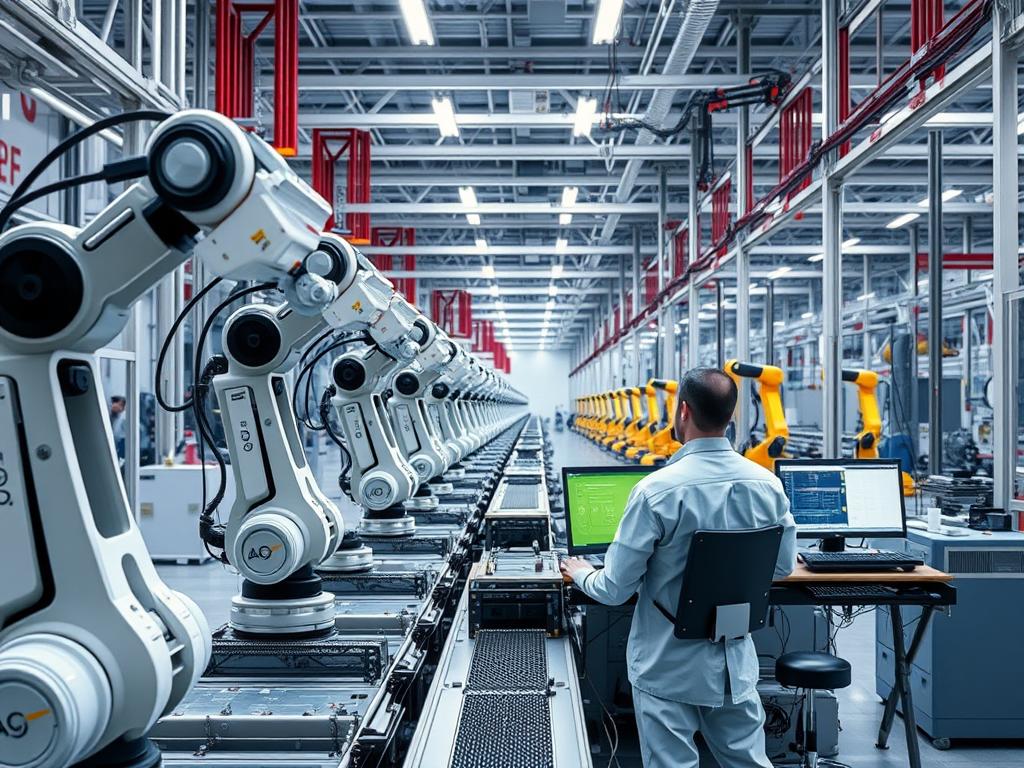The rise of artificial intelligence is reshaping the American workforce at an unprecedented pace. According to a recent Pew Research study, 52% of US professionals are concerned about AI’s impact on their jobs. This anxiety isn’t unfounded—the World Economic Forum projects that while AI will create 97 million new positions by 2025, it will also displace approximately 85 million existing roles. The question on many minds isn’t just whether AI will transform work, but which specific careers face the highest risk of automation in the coming years.
Understanding AI’s Impact on the US Job Market
The integration of artificial intelligence into workplaces isn’t just a future concern—it’s happening now. In early 2023, Goldman Sachs released a report estimating that AI automation could affect 300 million jobs globally, with US workers facing significant disruption. Unlike previous technological revolutions that primarily affected manual labor, today’s AI systems are increasingly capable of performing cognitive tasks once thought to require human intelligence.
Mark Zuckerberg’s recent statement at Meta exemplifies this shift: “We want to raise the bar on talent and accelerate hiring in AI and machine learning roles.” This came immediately after announcing a 5% workforce reduction. This pattern is repeating across industries as companies prioritize AI integration over traditional staffing models.

Before examining specific at-risk careers, it’s important to understand what makes a job vulnerable to AI replacement. Common factors include:
- Repetitive, predictable tasks with clear rules
- Data-heavy decision making that follows consistent patterns
- Limited requirement for creative thinking or emotional intelligence
- Minimal need for complex physical manipulation or human interaction
- Standardized outputs that can be evaluated algorithmically
10 Careers at High Risk from AI in the US
Based on current AI capabilities and adoption rates, these ten careers face significant job displacement risk in the American job market. Understanding why these roles are vulnerable can help professionals in these fields prepare for the changing landscape.

1. Data Entry Specialists
Why it’s vulnerable: Data entry involves repetitive tasks following predetermined rules—precisely what AI excels at. Modern optical character recognition (OCR) and natural language processing (NLP) systems can extract, categorize, and input data faster and with fewer errors than humans.
AI tools disrupting the field: UiPath, Automation Anywhere, and Microsoft Power Automate already automate complex data entry workflows in many organizations.
Timeline: 75% of data entry positions could be automated by 2025, according to McKinsey Global Institute projections.
2. Customer Service Representatives
Why it’s vulnerable: AI-powered chatbots and virtual assistants have advanced dramatically in their ability to understand and respond to customer inquiries. They can handle multiple conversations simultaneously and access vast knowledge bases instantly.
AI tools disrupting the field: ChatGPT, Google’s Customer Care AI, and IBM Watson Assistant are already handling millions of customer interactions daily.
Timeline: Gartner predicts that by 2026, 25% of customer service operations will be entirely AI-managed, with no human intervention.

3. Bookkeepers and Basic Accounting Roles
Why it’s vulnerable: Accounting software has already automated many bookkeeping functions. AI systems can now process invoices, reconcile accounts, and generate financial reports with minimal human oversight.
AI tools disrupting the field: QuickBooks AI, Sage Accounting, and Xero’s machine learning features are reducing the need for manual bookkeeping.
Timeline: The Bureau of Labor Statistics projects a 5% decline in bookkeeping jobs by 2030, largely due to automation.
4. Transportation and Delivery Drivers
Why it’s vulnerable: Self-driving technology continues to advance, with companies like Waymo and Tesla making significant progress in autonomous vehicle capabilities. Long-haul trucking routes—with their predictable highway driving—are particularly susceptible.
AI tools disrupting the field: Waymo One, Tesla Autopilot, and TuSimple’s autonomous trucking systems are already operating on US roads.
Timeline: McKinsey estimates that 15-20% of long-haul trucking could be autonomous by 2027, with urban delivery following by 2030.
5. Content Creation (Basic)
Why it’s vulnerable: AI writing tools can now generate articles, product descriptions, and marketing copy that often passes for human-written content. While creative and investigative journalism remains AI-resistant, routine content production is increasingly automated.
AI tools disrupting the field: GPT-4, Jasper, and Copy.ai are already being used by major publications and marketing departments.
Timeline: By 2025, an estimated 30% of digital content could be AI-generated, according to Forrester Research.

6. Financial Analysts (Junior Level)
Why it’s vulnerable: Entry-level financial analysis often involves gathering and processing data, identifying patterns, and generating reports—tasks that AI systems excel at. Machine learning algorithms can analyze market trends and make predictions faster than human analysts.
AI tools disrupting the field: Bloomberg Terminal AI features, Kensho, and AlphaSense are automating financial research and analysis.
Timeline: Goldman Sachs estimates that 30% of junior analyst tasks could be automated by 2026.
7. Legal Assistants and Paralegals
Why it’s vulnerable: Document review, legal research, and contract analysis—staples of paralegal work—are increasingly handled by AI systems that can process thousands of documents in hours rather than weeks.
AI tools disrupting the field: ROSS Intelligence, LexisNexis Legal Analytics, and Kira Systems are transforming legal research and document review.
Timeline: Deloitte predicts that 39% of legal jobs could be automated by 2028.
8. Manufacturing Workers
Why it’s vulnerable: Robotics and AI-powered systems continue to replace human workers in manufacturing settings. Modern systems can not only perform repetitive assembly tasks but also adapt to variations and conduct quality control.
AI tools disrupting the field: Boston Dynamics’ robots, FANUC intelligent robots, and Siemens’ autonomous factory systems are reducing human involvement in manufacturing.
Timeline: The World Economic Forum estimates that 20 million manufacturing jobs will be lost to automation globally by 2030.

9. Insurance Underwriters
Why it’s vulnerable: Insurance underwriting involves assessing risk based on data analysis—a process that machine learning algorithms can perform with greater speed and often more accuracy than humans. AI systems can analyze thousands of variables simultaneously to determine appropriate premiums.
AI tools disrupting the field: Lemonade’s AI Jim, Tractable, and Cape Analytics are automating underwriting decisions.
Timeline: Accenture projects that 40% of insurance underwriting tasks will be automated by 2027.
10. Retail Cashiers
Why it’s vulnerable: Self-checkout systems are already common, but the next generation of retail automation includes completely cashier-less stores using computer vision and sensor fusion to track purchases automatically.
AI tools disrupting the field: Amazon Go technology, Standard Cognition, and Grabango are enabling checkout-free shopping experiences.
Timeline: The Bureau of Labor Statistics projects a 10% decline in cashier jobs by 2030, primarily due to automation.
Worried About Your Career’s AI Risk?
Take our free assessment to evaluate how vulnerable your specific role is to automation and receive personalized recommendations for future-proofing your career.
Common Factors Making These Careers Vulnerable to AI
Looking across these high-risk careers, several patterns emerge that can help us understand what makes certain jobs particularly susceptible to AI automation:
Technical Vulnerability Factors
- Routine cognitive work: Jobs involving predictable analysis and decision-making based on clear rules
- Data processing: Roles that primarily involve organizing, analyzing, or transforming information
- Pattern recognition: Work that requires identifying trends or anomalies in data sets
- Standardized communication: Customer interactions that follow predictable scripts or protocols
- Structured environments: Jobs performed in controlled settings with limited variables
Business Factors Accelerating Adoption
- Cost efficiency: AI systems typically cost less than human employees over time
- Scalability: AI can handle volume spikes without additional hiring
- 24/7 availability: AI doesn’t require breaks, vacations, or sleep
- Consistency: AI performs tasks with the same quality regardless of time or conditions
- Data integration: AI can seamlessly connect with existing digital systems

Understanding these vulnerability factors can help professionals assess their own career risk and identify which aspects of their work might be candidates for automation. Importantly, jobs rarely disappear entirely—they more often transform as certain tasks are automated while others remain human-centered.
Action Plan: What to Do If Your Career Is at Risk
If you work in one of these high-risk fields—or see similar patterns in your own career—there are proactive steps you can take to adapt and thrive in an AI-transformed job market:

1. Develop Hybrid Human-AI Skills
Rather than competing against AI, focus on developing skills that complement it. This “hybrid intelligence” approach positions you as someone who can work effectively alongside AI systems.
Key Hybrid Skills to Develop:
- AI prompt engineering: Learning to effectively direct AI tools
- AI output evaluation: Critically assessing and refining AI-generated content
- AI implementation strategy: Identifying where and how AI can be effectively deployed
- Human-AI collaboration: Working effectively with AI as a team member
2. Emphasize Uniquely Human Capabilities
Focus on developing skills that AI currently struggles with—these “AI-resistant” capabilities will remain valuable even as automation increases.
Human Skills to Emphasize:
- Emotional intelligence: Understanding and responding to human emotions
- Creative problem-solving: Finding novel solutions to complex challenges
- Ethical decision-making: Navigating morally ambiguous situations
- Interpersonal persuasion: Influencing others through relationship building
- Cultural sensitivity: Adapting to diverse cultural contexts
Ways to Demonstrate These Skills:
- Lead cross-functional projects requiring stakeholder management
- Volunteer for innovation initiatives within your organization
- Develop case studies of situations where you applied these skills
- Seek certifications in areas like emotional intelligence or creative leadership

3. Consider Career Pivots to Lower-Risk Fields
For those in highly vulnerable roles, transitioning to adjacent fields with lower automation risk may be the most strategic move.
| High-Risk Career | Lower-Risk Pivot Options | Transferable Skills | Additional Training Needed |
| Data Entry Specialist | Data Quality Analyst, AI Training Data Specialist | Attention to detail, data literacy, process knowledge | Basic data analysis, SQL, quality assurance methods |
| Customer Service Rep | Customer Experience Designer, AI Customer Service Supervisor | Empathy, communication, problem-solving | UX design basics, AI chatbot management |
| Bookkeeper | Financial Systems Analyst, Accounting Technology Consultant | Financial knowledge, attention to detail, systems thinking | Advanced accounting software, data analytics |
| Delivery Driver | Logistics Coordinator, Last-Mile Delivery Specialist | Route optimization, customer service, time management | Supply chain management, logistics software |
| Content Creator (Basic) | Content Strategist, AI Content Editor/Supervisor | Writing ability, audience awareness, research skills | Content strategy, AI writing tool expertise |
4. Become an AI Implementation Specialist
One of the most direct ways to future-proof your career is to become part of the AI implementation process itself. Organizations need people who understand both the business context and the technical possibilities of AI.

Roles in this space include:
- AI Ethics Officer: Ensuring AI systems are deployed responsibly and ethically
- AI Trainer: Providing the human feedback needed to improve AI systems
- Automation Consultant: Helping businesses identify automation opportunities
- Human-AI Integration Specialist: Designing workflows that combine human and AI capabilities
The Future of Work: Adaptation, Not Elimination
While the rise of AI presents legitimate challenges for many careers, history suggests that technological revolutions typically transform rather than eliminate work. The industrial revolution shifted labor from farms to factories; the digital revolution moved many workers from factories to offices; the AI revolution will likely create new categories of work we can’t yet fully envision.

What’s different about the AI revolution is its pace and breadth. Previous technological shifts unfolded over generations; AI’s impact is being felt within career spans. This acceleration means that adaptability—the ability to learn, unlearn, and relearn—may be the most valuable skill of all.
The most successful professionals in the AI era won’t be those who resist change, but those who embrace it—finding ways to leverage AI as a powerful tool that amplifies their uniquely human capabilities. By understanding which careers face the highest risk, recognizing the patterns that make jobs vulnerable, and taking proactive steps to adapt, today’s workers can navigate the AI transformation successfully.
“The question isn’t whether AI will replace jobs, but how we can evolve our skills to work alongside increasingly capable AI systems. The future belongs to those who can combine human creativity and judgment with AI’s analytical power.”
Future-Proof Your Career in the AI Era
Download our comprehensive guide to navigating career transitions in high-risk fields. You’ll receive actionable strategies, upskilling resources, and personalized advice for thriving alongside AI.
Frequently Asked Questions About AI and Job Security
How quickly will AI replace jobs in these high-risk fields?
The timeline varies significantly by industry and specific role. Some fields like data entry and basic customer service are already seeing substantial automation, while others like transportation may take 5-10 years for widespread displacement. Rather than complete replacement, most fields will experience gradual task automation, with jobs evolving rather than disappearing overnight.
Will AI create enough new jobs to replace those it eliminates?
Historical evidence suggests that technological revolutions ultimately create more jobs than they destroy, but the transition period can be challenging. The World Economic Forum estimates that while 85 million jobs may be displaced by AI by 2025, 97 million new roles may emerge. However, these new jobs often require different skills than those being automated, highlighting the importance of continuous learning and adaptation.
What industries are most resistant to AI automation?
Industries requiring high emotional intelligence, creativity, and complex physical skills tend to be more resistant to automation. Healthcare (especially direct patient care), education, skilled trades (plumbers, electricians), creative fields (when involving original work rather than formulaic content), and roles requiring complex social interactions typically have lower automation risk.
How can I tell if my specific job is at high risk from AI?
Assess your daily tasks and determine what percentage involves routine, predictable work versus tasks requiring creativity, emotional intelligence, or complex physical skills. Jobs with more than 70% routine cognitive tasks are generally at higher risk. Also consider whether your role primarily processes information according to established rules or requires judgment in ambiguous situations—the former is more automatable than the latter.








